In this month’s newsletter (sign up on this page if you haven’t already), I told the story of Gordon and the onion.
It’s a true story about Gordon helping out his neighbour, Jim, by lending him a load of bits and pieces to fix up a car engine.
But the final item on Jim’s list – an onion – blows poor Gordon’s mind.
With his mechanic’s thinking hat on, Gordon can’t make the leap from workshop to kitchen and assumes this last item must be an exotic and unfamiliar tool.
Maybe something like this has happened to you?
In our house, having my laser focus on work broken by a question from my wife is a daily occurrence: “So, what did he say?” She’ll ask.
Or: “Did you manage to sort it out?”
These are invariably questions referring back to conversations we had hours ago and irrelevant to whatever I happen to have my head buried in at that moment.
Trying to think back and understand their context is brain-breaking.
Throughout the patient journey, there are plentiful opportunities to break the fundamental law of contextual congruence without realising.
It doesn’t have to be as much of a curveball as Gordon’s onion or a question from nowhere. Transgressions can be much more subtle, but the effect is the same: You break the ‘buy’ circuit in the patient’s brain and lose the lead forever.
Meet James – a Loose Denture Sufferer
To illustrate how this works – and how we can avoid it – let’s put ourselves in the shoes of James, a loose denture wearer who’s in the market for dental implants.
Here’s what we know about James:
- He never leaves home without denture glue
- He’s a former foodie now living on a restricted soft-food diet
- He feels self-conscious about smiling and avoids social gatherings
- He’s a dental phobic with a deep distrust of dentists
And for argument’s sake, let’s imagine our initial social ad piques James’ interest because it speaks to each of these specific pain points:
“Are you one of the thousands of people in the UK living with loose dentures? Do you wish you could bite into an apple or enjoy a steak again? Maybe you feel your failing smile is always the centre of attention?
“If you answered yes to any of these questions, why not book a free consultation with implant surgeon Dr Chohan. With over a decade of experience, including treating many nervous and phobic patients, Dr Chohan is the go-to expert for life-changing implant treatment…”
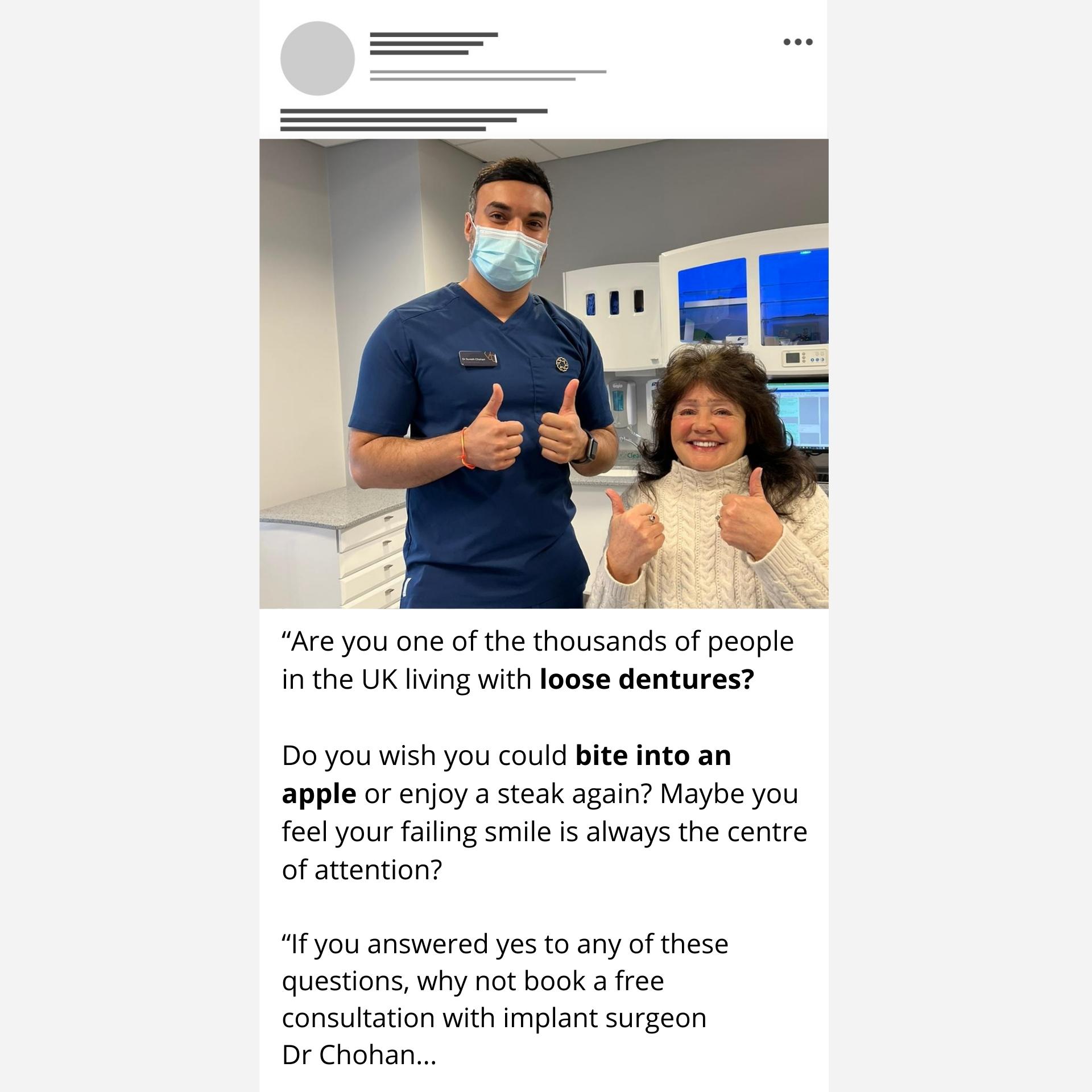
Seated alongside a picture of the rather dishy Dr Chohan, this ad is powerful stuff, and the patient clicks to find out more and book a free consultation.
Here’s our first chance to mess things up by breaking the rule of contextual congruency.
- Does the landing page talk about the same pain points as the ad?
- Does it mention Dr Chohan’s expertise with nervous patients?
- Is there a relevant call to action for the free consultation?
All too often, ads will lead to a general page about implants with the clinic’s phone number and expect the patient to fill in the gaps. In the worst case, it’ll lead to the clinic’s home page or cosmetic dentistry page. In both examples, there’s no contextual congruency, the patient’s buy circuit disengages, and the lead is gone forever.
A contextually relevant landing page might contain:
- More detail about food, self-confidence and other related pain points
- Testimonials from other patients that speak to the same problems
- Information about how implants can help
- Information about Dr Chohan’s implant expertise and experience with nervous patients
- A booking form to arrange the free consultation
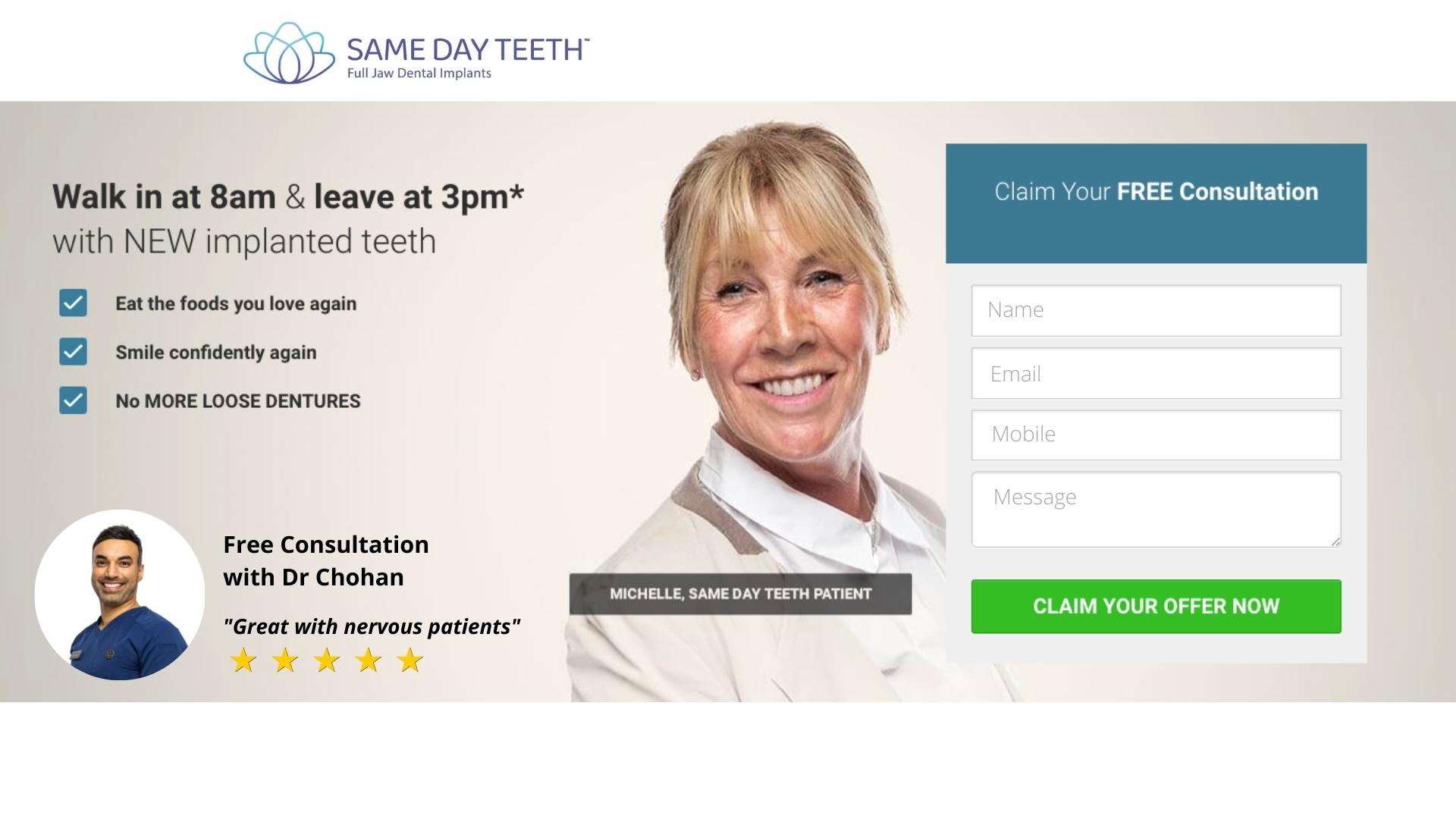
This is the first opportunity of many to introduce contextual congruency to the patient journey.
For example, your “thank you page” after submitting your enquiry might include a message that reads:
“Thanks for your enquiry, a member of our team will be in touch shortly.”
Compare that to the following message with a link to some success stories:
“Thanks for getting in touch, I’ll call you shortly to arrange your free consultation with Dr Chohan. You’ve just taken your first step to food freedom, complete confidence and a lifetime of healthy smiles.
In the meantime, please scroll down to watch some success stories about patients who have had life-transforming treatment by Dr Chohan.”
The first thankyou message leaves the patient hanging – maybe even wondering why a lowly team member will be in touch when Dr Chohan is the man of the hour.
In contrast, the second message stokes the fire by sending the patient to a page where they fall deeper in love and affirm their growing belief that only Dr C has the answer.
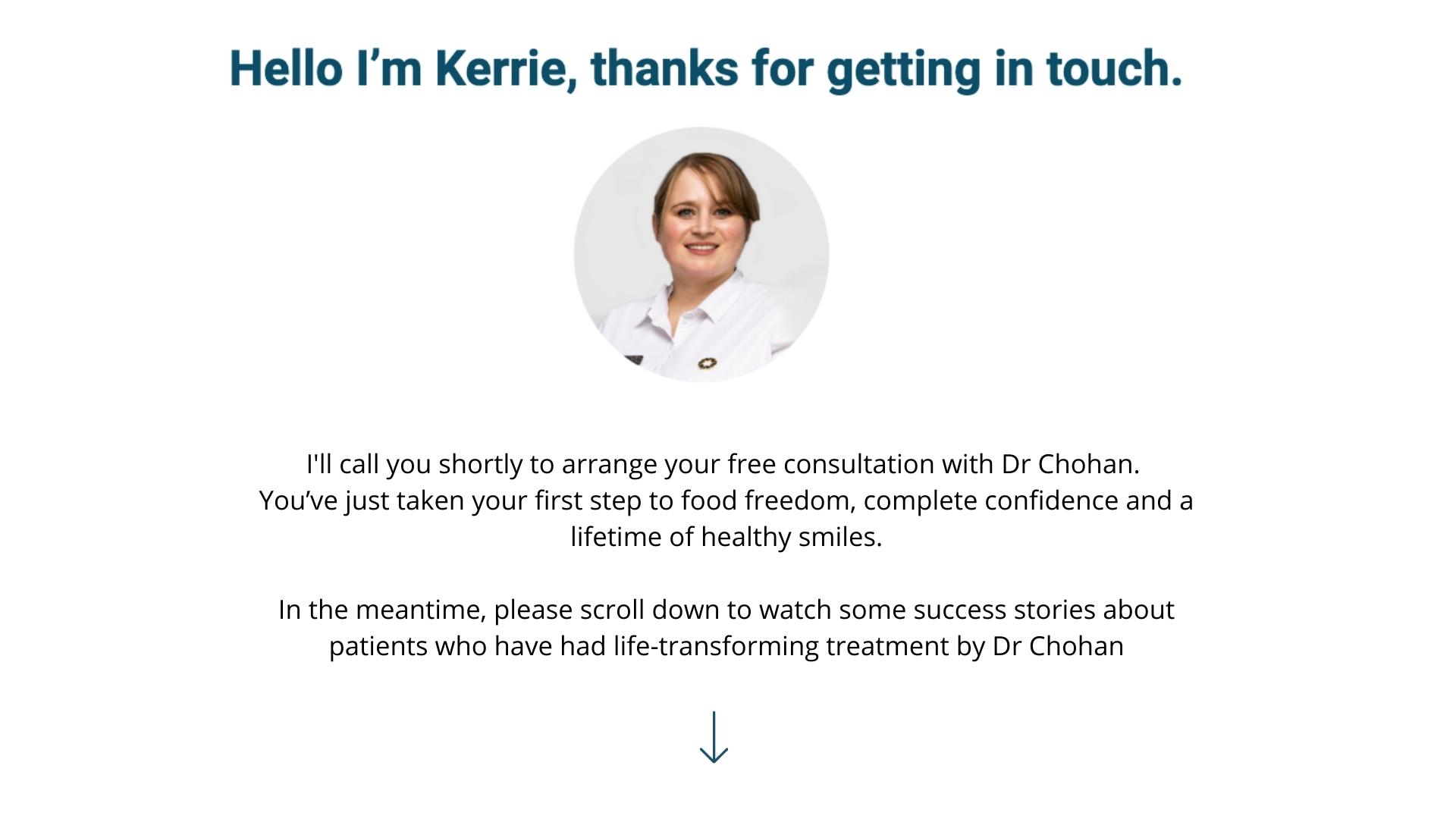
Next, let’s imagine a dental receptionist calls James to arrange the consultation and leaves the following answerphone message:
“Hello, James, this is a quick call to arrange your consultation. I’ll try again later, or feel free to call us and arrange a suitable time when you get this message…”
Sounds okay, right? But let’s add a little context and see what happens:
“Hello, James. This is a quick call to arrange your free consultation with Dr Chohan. I’ve discussed your message with him, and he is confident he can help you get back to having a balanced diet and feeling confident again…”
Notice how message number two continues the love story and doesn’t lose sight of the patient’s unique pain point.
You send an email: “Dear James, I just wanted to follow up as you enquired with us a few days ago and wondered if you’d like to attend a free consultation to discuss dental implants?”
Try instead: “Hello James I thought you might like to see one of Dr Chohan’s recent success stories. Simon, pictured below was a loose denture wearer who had a dental phobia, avoided the dentist for over 10 years and avoided socialising to the point he was depressed. He missed eating solid foods and had to blend his food in a processor before meals. The second photo shows Simon celebrating his daughter’s graduation in a restaurant! Let us know if you’d like to book a free consultation.”
Notice how we’re still addressing the patient’s unique pain points, even after all this time.
And why stop there? By the time you greet the patient for their consultation (Dr Chohan is really looking forward to meeting you…), James will be positively knock-kneed in anticipation of the chance to finally meet his man-crush and saviour.
Perhaps what I’ve described so far seems too obvious. But in my experience, a lack of context and congruency is the number-one reason why the patient acquisition process fails and leads go cold somewhere along the line.
So ask yourself:
- Is my message consistent at every point along the sales funnel?
- Is my marketing message aligned with my sales process?
- What processes could I put in place to improve congruency along the patient journey?
The answers might surprise you – and could change your patient journey for the better.
I talk about contextual congruence a lot. I’ve put together a half-hour podcast on the subject you can delve into for more insight.
If my thoughts inspire you to get all contextual and congruent, drop me a line and let me know how it works out for you.
Oh, and about that newsletter signup link: You’ll find it right at the bottom of this page. Sign up to receive my thoughts on practice growth and marketing straight to your inbox and be the first to find out when a new blog lands here on my site.



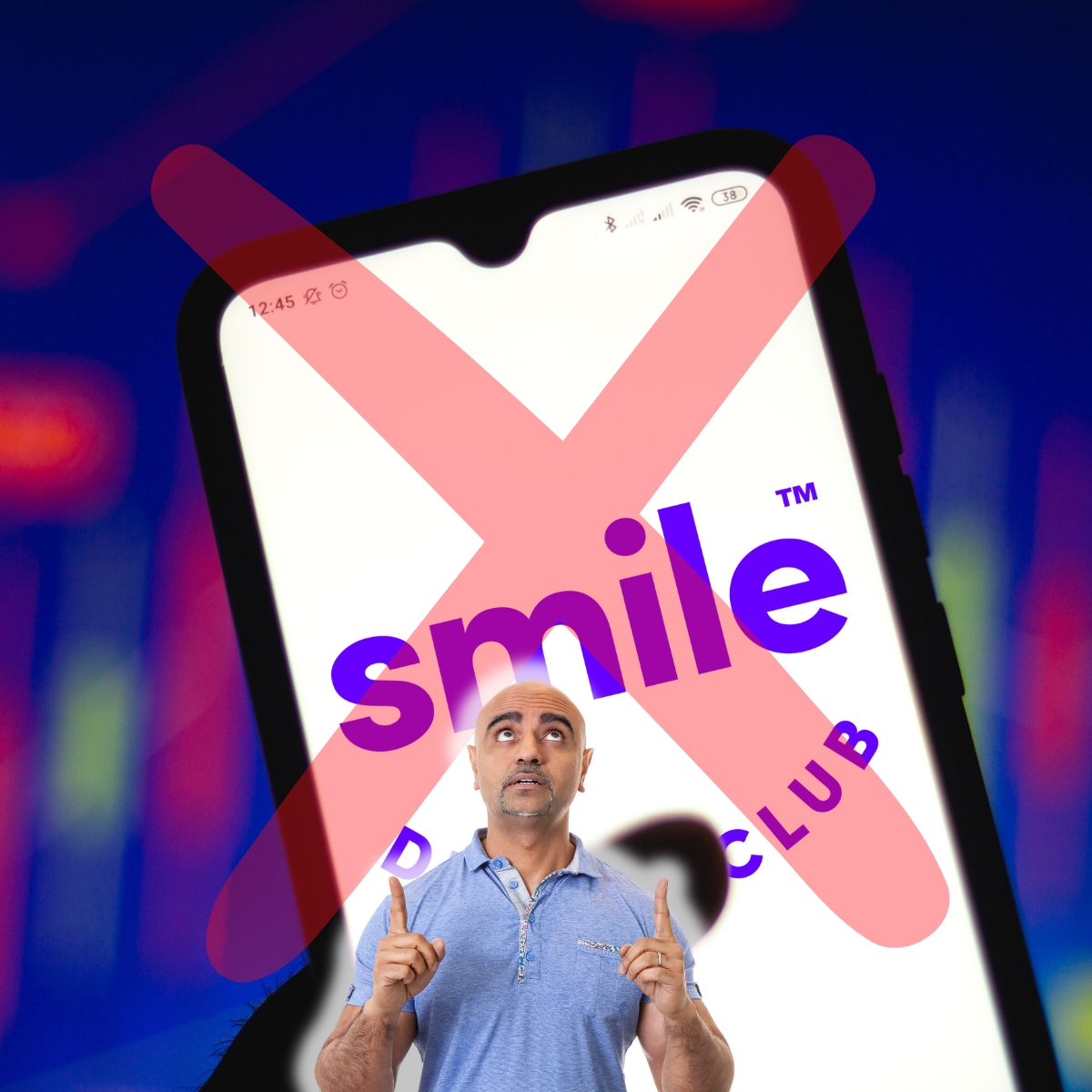
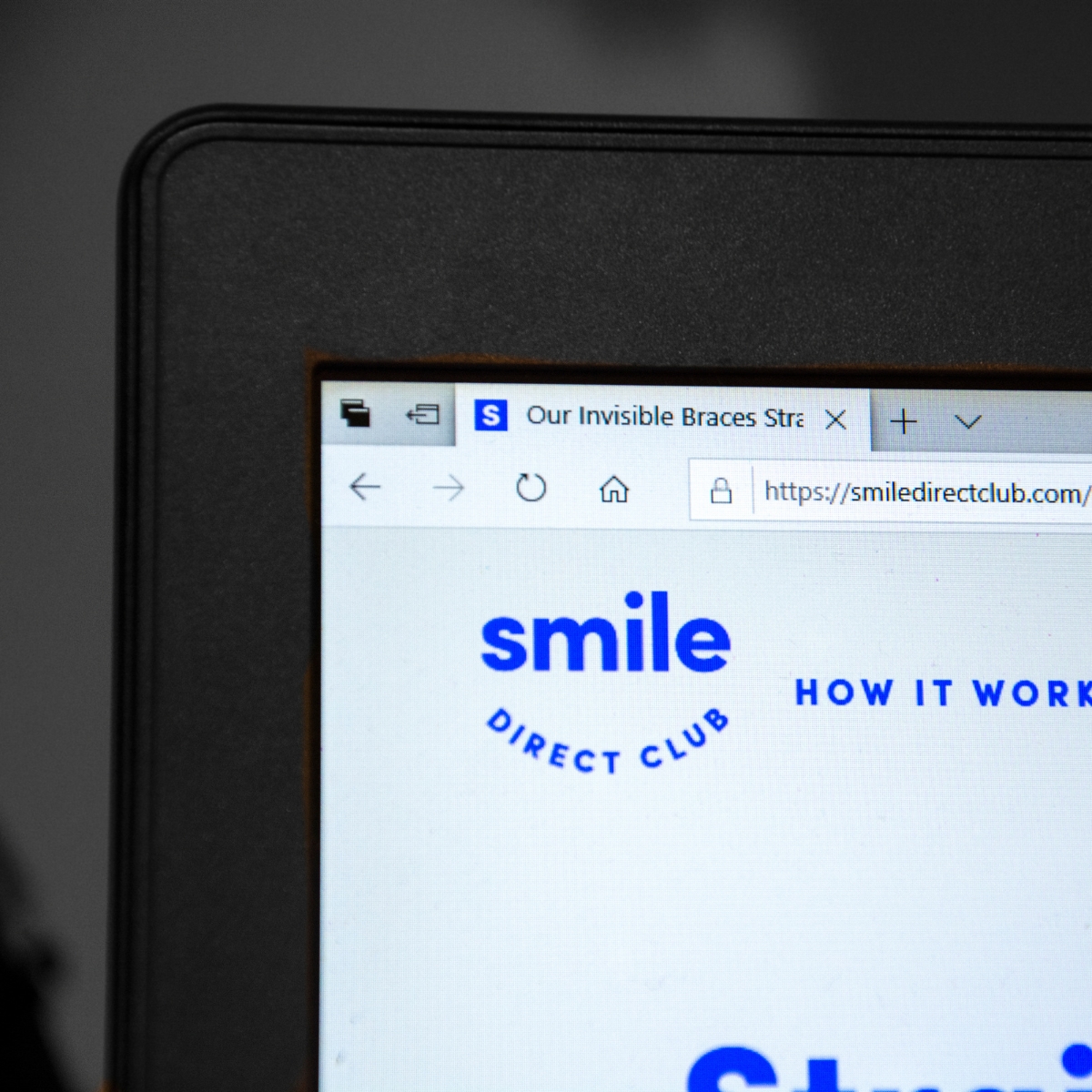


Your thoughts.